
Imperial forums
Encyclopedia
The Imperial Fora consist of a series of monumental fora
(public squares), constructed in Rome
over a period of one and half centuries, between 46 BC and 113 AD. The forums
were the center of the Roman Republic
and of the Roman Empire
.
The Imperial forums, while not part of the Roman Forum
, are located relatively close to each other. Julius Caesar was the first to build in this section of Rome and rearranged both the Forum and the Comitium, another forum type space designated for politics, to do so. These forums were the centres of politics, religion and economy in the ancient Roman Empire.
During the early 20th century, the Fascist
Italian Prime Minister Benito Mussolini
revamped the Imperial Fora as part of his campaign to evoke and emulate the past glories of Roman
and Italian history
.
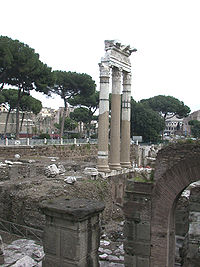 Julius Caesar
Julius Caesar
decided to construct a large forum bearing his name. This forum was inaugurated in 46 BC, though it was probably incomplete at this time and was finished later by Augustus.
The Forum of Caesar was constructed as an extension to the Roman Forum. The Forum was used as a replacement venue to the Roman Forum for public affairs as well as government; it was also designed as a celebration of Caesar's power. Caesar had placed, on the front of his forum, a temple devoted to Venus Genitrix, since Caesar's family (gens
Julia
) claimed to descend by Venus
through Aeneas
. A statue of Caesar himself riding Bucephalus
, the celebrated horse of Alexander the Great, was placed in front of the temple, to symbolise absolute power. This centralised vision corresponded to the ideological function, following the propaganda of the Hellenistic sanctuaries; also the choice of the Forum site carried a meaning: the future dictator didn't want to be far from the central power, represented in the Curia
, seat of the Senate. In fact, not long before Caesar's death, the Senate agreed to reconstruct the Curia on the site.
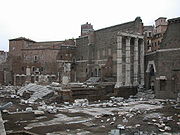 In the battle of Philippi
In the battle of Philippi
in 42 BC, in which Augustus and Mark Antony
worked together and avenged Caesar's death, defeating the forces of Brutus
and Cassius
, Augustus vowed to build the Temple of Mars Ultor ("Mars the Avenger"). The incomplete forum was inaugurated, after 40 years of construction, in 2 BC, adding the second monumental square, the Forum of Augustus.
This new complex lies at right angles to the Forum of Caesar. The temple consists of a very tall wall, and this still distinguishes itself from the popular neighbourhood of Suburra
. This high wall served as a firebreak, protecting the Forum area from the frequent conflagrations from which Rome suffered. The rectangular square has long deep porticos with a surface that widens into large semicircular exedras.
Recently one more slightly smaller exedra was found south on the wall bordering the forum of Trajan. meaning that in sake of symmetry there must have been other exedra demolished to make room for the forum of Nerva, rising the number to 4 and not 2 exedras. This completely changes the layout for the south part of the forum of Augustus, meaning that it is much more similar to the forum of Trajan, and a new theory for this southern part of the forum suggests that in fact there was a basilica between the 2 new exedras (like in the forum of Trajan). This supports the numerous ancient authors that tell us the forum was used as a court of law.
The entire decoration of the Forum was tightly connected to the ideology of Augustus
. According to myth, Rome herself was born from the god Mars through Romulus
. This forum was occupied by many plebeians as well as senators.
. Separated from the Forum of Augustus, the Forum of Caesar and the Via dell'Argileto which connect the Roman Forum to the Subura, the temple faced the Velian Hill
(in the direction of the Colosseum
). The fact that this structure is not mentioned as having a civil function has prevented it from being classified as a true Forum. Therefore the structure was simply identified as the Temple of Peace (Templum Pacis) until the late Empire.
The shape of the square was also different: the temple was constructed as a large apsidal hall that opened up like an exedra at the bottom of the portico. A row of columns distinguished the portico from the temple. The central area was not paved like other fora and served as a garden, with pools and pedestals for statues, so that it was similar to an open-air museum.
The monument was built to celebrate the conquest of Jerusalem
. One of the chambers opened at the end of the porticos housed the Forma Urbis Romae
, a marble map of ancient Rome, made in the Severan period (3rd century) by drawing on the marble slab that covered the wall. The wall is now part of the façade of the church of Santi Cosma e Damiano
, where the holes used to mount the slabs of the map can still be seen. The Temple of Peace is also said to have housed the Menorah from Herod's Temple.
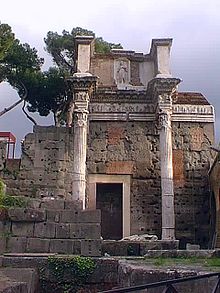 Domitian
Domitian
decided to unify the previous complex and the free remaining irregular area, between the Temple of Peace and the Fora of Caesar and Augustus, and build another monumental forum which connected all of the other fora.
The limited space, partially occupied by one of the exedrae of the Forum of Augustus and by the via dell'Argileto, obliged Vespasian to build the lateral porticos as simply decorations of the bounding walls of the forum. The temple, dedicated to Minerva
as protector of the emperor, was built leaning on the exedra of the Forum of Augustus, so that the remaining space became a large monumental entrance (Porticus Absidatus) for all the fora.
Because of the death of Domitian, the forum was inaugurated by his successor, Nerva
, who gave his own name to it. The Forum of Nerva is also known as Transitional Forum, because it worked as an access way, just like via dell'Argileto had done.
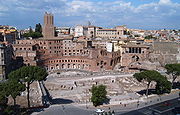
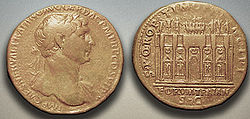 It is probable that Domitian's projects were more ambitious than the building of the small "Forum of Nerva", and probably under his reign they started to remove the small saddle that united the Capitoline Hill
It is probable that Domitian's projects were more ambitious than the building of the small "Forum of Nerva", and probably under his reign they started to remove the small saddle that united the Capitoline Hill
to the Quirinal Hill
, thus blocking the Fora towards Campus Martius
, near to modern Piazza Venezia
.
The project was resumed by Trajan
with the construction of Trajan's Forum
between 112 and 113. The occasion was the conquest of Dacia
, whose spoils paid for this celebration of the military conquests of Rome.
The preparation of the Forum required a lot of work. It was necessary to remove the hilly saddle, and to support the cut of Quirinal Hill through the building of the Trajan's market. The Forum square was closed by the Basilica Ulpia
, with Trajan's Column
at its back. In front of the basilica, a monumental façade was the background of a large, equestrian sculpture of the Emperor. The last Forum was also the biggest and greatest.
The purpose of this bibliographical reference paper is to provide university students, scholars with a supplementary updated bibliographical listing of the more recent scholarly publications and Italian news articles ([ca. 150 + listings] dating from 1995 to Oct. 2010) in reference to the Fascist period excavations in the Imperial Forums and simultaneous construction of the Via dell‟ Impero [now Via dei Fori Imperiali] between 1930-1936.
- Introduction, pp. 1-2.
- Part. 1. “Via dell’impero. Nascita di una strada, demolizioni e scavi: 1930-1936. Scavi archeologici, sterri e demolizioni per l’apertura di via dell’Impero.” by: Umberto Broccoli, Claudio Parisi Presicce, & Maria Elisa Tittoni. Rome, July 22, 2009, pp. 3-7.
- Part. 2. Bibliography, Further Reading and [with Electronic] References, pp. 8-21.
Forum (Roman)
A forum was a public square in a Roman municipium, or any civitas, reserved primarily for the vending of goods; i.e., a marketplace, along with the buildings used for shops and the stoas used for open stalls...
(public squares), constructed in Rome
Rome
Rome is the capital of Italy and the country's largest and most populated city and comune, with over 2.7 million residents in . The city is located in the central-western portion of the Italian Peninsula, on the Tiber River within the Lazio region of Italy.Rome's history spans two and a half...
over a period of one and half centuries, between 46 BC and 113 AD. The forums
Forum (Roman)
A forum was a public square in a Roman municipium, or any civitas, reserved primarily for the vending of goods; i.e., a marketplace, along with the buildings used for shops and the stoas used for open stalls...
were the center of the Roman Republic
Roman Republic
The Roman Republic was the period of the ancient Roman civilization where the government operated as a republic. It began with the overthrow of the Roman monarchy, traditionally dated around 508 BC, and its replacement by a government headed by two consuls, elected annually by the citizens and...
and of the Roman Empire
Roman Empire
The Roman Empire was the post-Republican period of the ancient Roman civilization, characterised by an autocratic form of government and large territorial holdings in Europe and around the Mediterranean....
.
The Imperial forums, while not part of the Roman Forum
Roman Forum
The Roman Forum is a rectangular forum surrounded by the ruins of several important ancient government buildings at the center of the city of Rome. Citizens of the ancient city referred to this space, originally a marketplace, as the Forum Magnum, or simply the Forum...
, are located relatively close to each other. Julius Caesar was the first to build in this section of Rome and rearranged both the Forum and the Comitium, another forum type space designated for politics, to do so. These forums were the centres of politics, religion and economy in the ancient Roman Empire.
During the early 20th century, the Fascist
Fascism
Fascism is a radical authoritarian nationalist political ideology. Fascists seek to rejuvenate their nation based on commitment to the national community as an organic entity, in which individuals are bound together in national identity by suprapersonal connections of ancestry, culture, and blood...
Italian Prime Minister Benito Mussolini
Benito Mussolini
Benito Amilcare Andrea Mussolini was an Italian politician who led the National Fascist Party and is credited with being one of the key figures in the creation of Fascism....
revamped the Imperial Fora as part of his campaign to evoke and emulate the past glories of Roman
Ancient Rome
Ancient Rome was a thriving civilization that grew on the Italian Peninsula as early as the 8th century BC. Located along the Mediterranean Sea and centered on the city of Rome, it expanded to one of the largest empires in the ancient world....
and Italian history
History of Italy
Italy, united in 1861, has significantly contributed to the political, cultural and social development of the entire Mediterranean region. Many cultures and civilizations have existed there since prehistoric times....
.
Forum of Caesar

Julius Caesar
Gaius Julius Caesar was a Roman general and statesman and a distinguished writer of Latin prose. He played a critical role in the gradual transformation of the Roman Republic into the Roman Empire....
decided to construct a large forum bearing his name. This forum was inaugurated in 46 BC, though it was probably incomplete at this time and was finished later by Augustus.
The Forum of Caesar was constructed as an extension to the Roman Forum. The Forum was used as a replacement venue to the Roman Forum for public affairs as well as government; it was also designed as a celebration of Caesar's power. Caesar had placed, on the front of his forum, a temple devoted to Venus Genitrix, since Caesar's family (gens
Gens
In ancient Rome, a gens , plural gentes, referred to a family, consisting of all those individuals who shared the same nomen and claimed descent from a common ancestor. A branch of a gens was called a stirps . The gens was an important social structure at Rome and throughout Italy during the...
Julia
Julius
The gens Julia was one of the most ancient patrician families at Ancient Rome. Members of the gens attained the highest dignities of the state in the earliest times of the Republic. The first of the family to obtain the consulship was Gaius Julius Iulus in 489 BC...
) claimed to descend by Venus
Venus (mythology)
Venus is a Roman goddess principally associated with love, beauty, sex,sexual seduction and fertility, who played a key role in many Roman religious festivals and myths...
through Aeneas
Aeneas
Aeneas , in Greco-Roman mythology, was a Trojan hero, the son of the prince Anchises and the goddess Aphrodite. His father was the second cousin of King Priam of Troy, making Aeneas Priam's second cousin, once removed. The journey of Aeneas from Troy , which led to the founding a hamlet south of...
. A statue of Caesar himself riding Bucephalus
Bucephalus
Bucephalus or Bucephalas was Alexander the Great's horse and one of the most famous actual horses of antiquity. Ancient accounts state that Bucephalus died after the Battle of the Hydaspes in 326 BC, in what is now modern Pakistan, and is buried in Jalalpur Sharif outside of Jhelum, Pakistan...
, the celebrated horse of Alexander the Great, was placed in front of the temple, to symbolise absolute power. This centralised vision corresponded to the ideological function, following the propaganda of the Hellenistic sanctuaries; also the choice of the Forum site carried a meaning: the future dictator didn't want to be far from the central power, represented in the Curia
Curia
A curia in early Roman times was a subdivision of the people, i.e. more or less a tribe, and with a metonymy it came to mean also the meeting place where the tribe discussed its affairs...
, seat of the Senate. In fact, not long before Caesar's death, the Senate agreed to reconstruct the Curia on the site.
Forum of Augustus

Battle of Philippi
The Battle of Philippi was the final battle in the Wars of the Second Triumvirate between the forces of Mark Antony and Octavian and the forces of Julius Caesar's assassins Marcus Junius Brutus and Gaius Cassius Longinus in 42 BC, at Philippi in Macedonia...
in 42 BC, in which Augustus and Mark Antony
Mark Antony
Marcus Antonius , known in English as Mark Antony, was a Roman politician and general. As a military commander and administrator, he was an important supporter and loyal friend of his mother's cousin Julius Caesar...
worked together and avenged Caesar's death, defeating the forces of Brutus
Brutus
Brutus is the cognomen of the Roman gens Junia, a prominent family of the Roman Republic. The plural of Brutus is Bruti, and the vocative form is Brute, as immortalized in the quotation "Et tu, Brute?", from Shakespeare's play, Julius Caesar....
and Cassius
Gaius Cassius Longinus
Gaius Cassius Longinus was a Roman senator, a leading instigator of the plot to kill Julius Caesar, and the brother in-law of Marcus Junius Brutus.-Early life:...
, Augustus vowed to build the Temple of Mars Ultor ("Mars the Avenger"). The incomplete forum was inaugurated, after 40 years of construction, in 2 BC, adding the second monumental square, the Forum of Augustus.
This new complex lies at right angles to the Forum of Caesar. The temple consists of a very tall wall, and this still distinguishes itself from the popular neighbourhood of Suburra
Suburra
Suburra is an area of the city of Rome, Italy. In ancient Roman times, it was a crowded lower-class area that was also notorious as a red-light district. It lies in the dip between the southern end of the Viminal and the western end of the Esquiline hills...
. This high wall served as a firebreak, protecting the Forum area from the frequent conflagrations from which Rome suffered. The rectangular square has long deep porticos with a surface that widens into large semicircular exedras.
Recently one more slightly smaller exedra was found south on the wall bordering the forum of Trajan. meaning that in sake of symmetry there must have been other exedra demolished to make room for the forum of Nerva, rising the number to 4 and not 2 exedras. This completely changes the layout for the south part of the forum of Augustus, meaning that it is much more similar to the forum of Trajan, and a new theory for this southern part of the forum suggests that in fact there was a basilica between the 2 new exedras (like in the forum of Trajan). This supports the numerous ancient authors that tell us the forum was used as a court of law.
The entire decoration of the Forum was tightly connected to the ideology of Augustus
Augustus
Augustus ;23 September 63 BC – 19 August AD 14) is considered the first emperor of the Roman Empire, which he ruled alone from 27 BC until his death in 14 AD.The dates of his rule are contemporary dates; Augustus lived under two calendars, the Roman Republican until 45 BC, and the Julian...
. According to myth, Rome herself was born from the god Mars through Romulus
Romulus and Remus
Romulus and Remus are Rome's twin founders in its traditional foundation myth, although the former is sometimes said to be the sole founder...
. This forum was occupied by many plebeians as well as senators.
Temple of Peace
In 75 AD, the Temple of Peace, also known as the Forum of Vespasian, was built under Emperor VespasianVespasian
Vespasian , was Roman Emperor from 69 AD to 79 AD. Vespasian was the founder of the Flavian dynasty, which ruled the Empire for a quarter century. Vespasian was descended from a family of equestrians, who rose into the senatorial rank under the Emperors of the Julio-Claudian dynasty...
. Separated from the Forum of Augustus, the Forum of Caesar and the Via dell'Argileto which connect the Roman Forum to the Subura, the temple faced the Velian Hill
Velian Hill
The Velia — or Velian Hill or Velian Ridge — is a saddle or spur stretching out from the middle of the north side of the Palatine Hill towards the Oppian Hill ....
(in the direction of the Colosseum
Colosseum
The Colosseum, or the Coliseum, originally the Flavian Amphitheatre , is an elliptical amphitheatre in the centre of the city of Rome, Italy, the largest ever built in the Roman Empire...
). The fact that this structure is not mentioned as having a civil function has prevented it from being classified as a true Forum. Therefore the structure was simply identified as the Temple of Peace (Templum Pacis) until the late Empire.
The shape of the square was also different: the temple was constructed as a large apsidal hall that opened up like an exedra at the bottom of the portico. A row of columns distinguished the portico from the temple. The central area was not paved like other fora and served as a garden, with pools and pedestals for statues, so that it was similar to an open-air museum.
The monument was built to celebrate the conquest of Jerusalem
Siege of Jerusalem (70)
The Siege of Jerusalem in the year 70 AD was the decisive event of the First Jewish-Roman War. The Roman army, led by the future Emperor Titus, with Tiberius Julius Alexander as his second-in-command, besieged and conquered the city of Jerusalem, which had been occupied by its Jewish defenders in...
. One of the chambers opened at the end of the porticos housed the Forma Urbis Romae
Forma Urbis Romae
The Forma Urbis Romae or Severan Marble Plan is a massive marble map of ancient Rome, created under the emperor Septimius Severus between 203 and 211...
, a marble map of ancient Rome, made in the Severan period (3rd century) by drawing on the marble slab that covered the wall. The wall is now part of the façade of the church of Santi Cosma e Damiano
Santi Cosma e Damiano
The basilica of Santi Cosma e Damiano is a church in Rome, Italy, located in the Roman Forum. It is one of the ancient churches called tituli, of which cardinals are patrons as deacons: the Cardinal Deacon of the Titulus Ss. Cosmae et Damiani is Giovanni Cheli...
, where the holes used to mount the slabs of the map can still be seen. The Temple of Peace is also said to have housed the Menorah from Herod's Temple.
Forum of Nerva, or the Transitional Forum

Domitian
Domitian was Roman Emperor from 81 to 96. Domitian was the third and last emperor of the Flavian dynasty.Domitian's youth and early career were largely spent in the shadow of his brother Titus, who gained military renown during the First Jewish-Roman War...
decided to unify the previous complex and the free remaining irregular area, between the Temple of Peace and the Fora of Caesar and Augustus, and build another monumental forum which connected all of the other fora.
The limited space, partially occupied by one of the exedrae of the Forum of Augustus and by the via dell'Argileto, obliged Vespasian to build the lateral porticos as simply decorations of the bounding walls of the forum. The temple, dedicated to Minerva
Minerva
Minerva was the Roman goddess whom Romans from the 2nd century BC onwards equated with the Greek goddess Athena. She was the virgin goddess of poetry, medicine, wisdom, commerce, weaving, crafts, magic...
as protector of the emperor, was built leaning on the exedra of the Forum of Augustus, so that the remaining space became a large monumental entrance (Porticus Absidatus) for all the fora.
Because of the death of Domitian, the forum was inaugurated by his successor, Nerva
Nerva
Nerva , was Roman Emperor from 96 to 98. Nerva became Emperor at the age of sixty-five, after a lifetime of imperial service under Nero and the rulers of the Flavian dynasty. Under Nero, he was a member of the imperial entourage and played a vital part in exposing the Pisonian conspiracy of 65...
, who gave his own name to it. The Forum of Nerva is also known as Transitional Forum, because it worked as an access way, just like via dell'Argileto had done.
Forum of Trajan


Capitoline Hill
The Capitoline Hill , between the Forum and the Campus Martius, is one of the seven hills of Rome. It was the citadel of the earliest Romans. By the 16th century, Capitolinus had become Capitolino in Italian, with the alternative Campidoglio stemming from Capitolium. The English word capitol...
to the Quirinal Hill
Quirinal Hill
The Quirinal Hill is one of the Seven Hills of Rome, at the north-east of the city center. It is the location of the official residence of the Italian Head of State, who resides in the Quirinal Palace; by metonymy "the Quirinal" has come to stand for the Italian President.- History :It was...
, thus blocking the Fora towards Campus Martius
Campus Martius
The Campus Martius , was a publicly owned area of ancient Rome about in extent. In the Middle Ages, it was the most populous area of Rome...
, near to modern Piazza Venezia
Piazza Venezia
The Piazza Venezia is a piazza in central Rome, Italy. It takes its name from Cardinal Venezia who built the adjacent Palazzo Venezia, the former embassy of the city of the Republic of Venice....
.
The project was resumed by Trajan
Trajan
Trajan , was Roman Emperor from 98 to 117 AD. Born into a non-patrician family in the province of Hispania Baetica, in Spain Trajan rose to prominence during the reign of emperor Domitian. Serving as a legatus legionis in Hispania Tarraconensis, in Spain, in 89 Trajan supported the emperor against...
with the construction of Trajan's Forum
Trajan's Forum
Trajan's Forum is an ancient structure in Rome, Italy, chronologically the last of the Imperial fora. The forum was constructed by the architect Apollodorus of Damascus.-History:...
between 112 and 113. The occasion was the conquest of Dacia
Dacia
In ancient geography, especially in Roman sources, Dacia was the land inhabited by the Dacians or Getae as they were known by the Greeks—the branch of the Thracians north of the Haemus range...
, whose spoils paid for this celebration of the military conquests of Rome.
The preparation of the Forum required a lot of work. It was necessary to remove the hilly saddle, and to support the cut of Quirinal Hill through the building of the Trajan's market. The Forum square was closed by the Basilica Ulpia
Basilica ulpia
The Basilica Ulpia was an ancient Roman civic building located in the Forum of Trajan. The Basilica Ulpia separates the temple from the main courtyard in the Forum of Trajan with the Trajan's Column to the northwest...
, with Trajan's Column
Trajan's Column
Trajan's Column is a Roman triumphal column in Rome, Italy, which commemorates Roman emperor Trajan's victory in the Dacian Wars. It was probably constructed under the supervision of the architect Apollodorus of Damascus at the order of the Roman Senate. It is located in Trajan's Forum, built near...
at its back. In front of the basilica, a monumental façade was the background of a large, equestrian sculpture of the Emperor. The last Forum was also the biggest and greatest.
Restoration from Mussolini
Mussolini’s Rome - The ‘Via Dell’ Impero’ and the ‘Imperial Forums’ (1924-40): The New Studies of the Fascist Systemization of the Imperial Forums and the Unpublished Archaeological Findings (1995-2010). pp. 1-21. Martin G. Conde, Oct. 2010.The purpose of this bibliographical reference paper is to provide university students, scholars with a supplementary updated bibliographical listing of the more recent scholarly publications and Italian news articles ([ca. 150 + listings] dating from 1995 to Oct. 2010) in reference to the Fascist period excavations in the Imperial Forums and simultaneous construction of the Via dell‟ Impero [now Via dei Fori Imperiali] between 1930-1936.
- Introduction, pp. 1-2.
- Part. 1. “Via dell’impero. Nascita di una strada, demolizioni e scavi: 1930-1936. Scavi archeologici, sterri e demolizioni per l’apertura di via dell’Impero.” by: Umberto Broccoli, Claudio Parisi Presicce, & Maria Elisa Tittoni. Rome, July 22, 2009, pp. 3-7.
- Part. 2. Bibliography, Further Reading and [with Electronic] References, pp. 8-21.
External links
- James Grout: Imperial Fora, part of the Encyclopædia Romana
- Satellite image of the Forums area
- Mussolini’s Rome - The ‘Via Dell’ Impero’ and the ‘Imperial Forums’ (1924-40): The New Studies of the Fascist Systemization of the Imperial Forums and the Unpublished Archaeological Findings (1995-2010). pp. 1-21. Martin G. Conde, Oct. 2010.
- Temple of Peace [Sector # A
(1998-2011): Archaeological Investigations, Related Studies, Exhibitions, Publications, & Digital Resources.] - Temple of Peace [Sector # B
(1998-2011): Archaeological Investigations, Related Studies, Exhibitions, Publications, & Digital Resources.] - Temple of Peace [Sector # C
(1998-2011): Archaeological Investigations, Related Studies, Exhibitions, Publications, & Digital Resources.]

